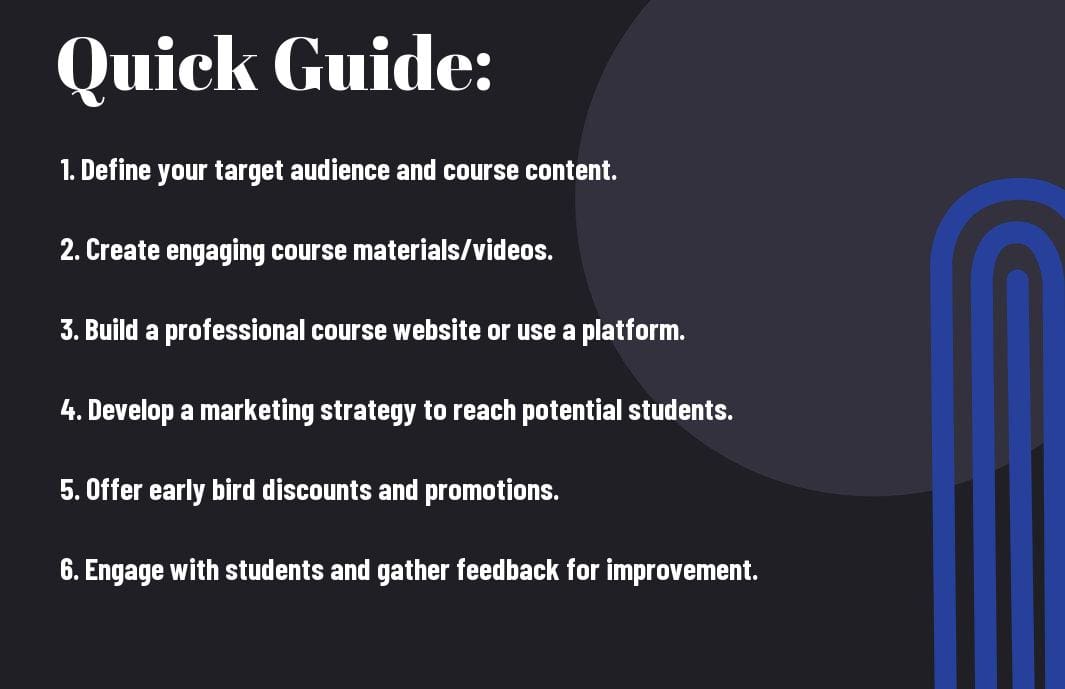Launching your online course can be a daunting task, but with the right strategy and knowledge, you can achieve success in this venture. This comprehensive guide will provide you with necessary steps, tips, and insights to ensure a smooth and effective launch of your online course. From creating compelling course content to marketing strategies and engaging with your audience, this guide covers critical aspects that will set you up for success. Learn how to avoid common pitfalls, maximize your reach, and build a profitable online course that resonates with your target audience. Follow this guide and launch on your journey to launch your online course with confidence and success.
Key Takeaways:
- Thorough Planning: Ensuring a successful online course launch involves thorough planning in terms of content creation, marketing strategies, and setting clear goals and timelines.
- Engage Your Audience: It is crucial to engage with your audience before and during the launch of your online course through social media, email newsletters, webinars, and other interactive platforms to build interest and anticipation.
- Provide Exceptional Value: Focusing on providing exceptional value to your students by offering high-quality content, resources, interactive elements, and continuous support can help in not only launching but also maintaining a successful online course.

Understanding Different Types of Online Courses
Any online course creator knows the importance of understanding the different types of online courses available. From self-paced courses to live instructional courses, there are various formats to consider. Each type caters to different learning styles and preferences, so it’s crucial to choose the right one for your audience.
| Self-Paced Courses | Live Instructional Courses |
| Flexible learning schedule | Real-time interaction with instructor |
| Individual progress tracking | Immediate feedback |
| Self-motivated learning | Structured learning environment |
| No fixed deadlines | Scheduled class sessions |
| Autonomous learning experience | Collaborative learning experience |
Self-Paced vs. Live Instructional Courses
To make a decision between self-paced courses and live instructional courses, you need to consider the learning preferences of your target audience. Self-paced courses offer flexibility and freedom to learners, allowing them to progress at their own pace. On the other hand, live instructional courses provide real-time interaction with instructors and a structured learning environment. Analyze your content and audience to determine which format will be most effective for achieving your course goals.
Supplements to Traditional Education vs. Standalone Courses
Any online course creator needs to decide whether they want to create supplements to traditional education or standalone courses. Supplements to traditional education courses are designed to support existing curriculum or learning programs, offering additional resources or alternative explanations. On the other hand, standalone courses are independent learning programs that cover a specific topic comprehensively. Little research shows that standalone courses can attract a broader audience, while supplements are targeted to a specific group of learners looking to enhance their knowledge in a particular subject.
Pre-Launch Strategies: Laying the Foundation
Knowing Your Audience
For a successful online course launch, understanding your audience is crucial. You need to know their demographics, interests, pain points, and aspirations to tailor your course content to their specific needs. Conduct surveys, engage with them on social media, and analyze data to gain valuable insights into what will resonate with your audience.
Creating Killer Content
Even the most well-researched course will fall flat without compelling content. Focus on creating content that is not only informative but also engaging and interactive. Use a variety of formats such as videos, quizzes, downloadable resources, and discussions to keep your audience interested and motivated throughout the course.
Audience engagement is key to the success of your online course. Interact with your audience through live Q&A sessions, discussion forums, and feedback surveys to keep them engaged and invested in the learning experience. Address their questions and concerns promptly and make them feel heard and supported throughout their learning journey.
The Ultimate Guide To Launching Your Online Course Successfully
Your Step-by-Step Guide to Launching Your Online Course
Technical Setup: Platforms and Tools
For a successful online course launch, choosing the right platform and tools is crucial. Consider platforms like Teachable, Thinkific, or Kajabi that offer user-friendly interfaces, customizable templates, and marketing integrations. Make sure your chosen platform supports multimedia content, provides secure payment options, and offers analytics to track student progress.
Marketing and Promotion: How to Build Hype
The key to a successful online course launch lies in effective marketing and promotion strategies. Start by creating a buzz around your course with teaser campaigns, social media posts, and email marketing. Collaborate with influencers in your niche, offer early bird discounts, and create engaging content that highlights the benefits of your course. Leverage platforms like Facebook Ads and Google AdWords to reach a wider audience.
Hype: Building hype around your online course can create a sense of anticipation and excitement among your target audience. By teasing various aspects of your course, showcasing testimonials, and offering sneak peeks, you can generate curiosity and drive enrollments. Make sure to communicate the unique selling points of your course and emphasize the value it will bring to your students.
Factors to Consider for Maximum Impact
Keep key factors in mind to ensure the success of your online course launch. Factors such as target audience, course content, marketing strategy, and pricing can significantly impact the overall outcome. Tailor your approach to these factors for maximum impact and engagement.
Pricing Your Courses
Courses should be priced strategically to attract students while also reflecting the value of the content. Consider factors such as course complexity, market demand, and competitor pricing when setting your prices. Finding the right balance can help you maximize profits and attract a larger audience. The key is to offer a price that justifies the value of the course.
Feedback and Continuous Improvement
Little feedback from students can provide valuable insights into areas that need improvement. Encourage students to provide feedback through surveys, reviews, and direct communication. Use this feedback to make continuous improvements to your course content, delivery, and overall student experience. The goal is to create a positive learning environment that fosters growth and success for your students. The key is to listen to student feedback and take action to implement necessary changes.
Tips to Enhance the Learning Experience
After creating your online course, it’s crucial to focus on enhancing the learning experience for your students. By implementing engagement and interaction techniques and utilizing multimedia and gamification, you can ensure that your course is not only informative but also enjoyable for your students.
Engagement and Interaction Techniques
While delivering your online course, it’s crucial to keep your students engaged and encourage interactions. Incorporate live Q&A sessions, discussion forums, and quizzes to foster engagement. Respond promptly to student queries and provide feedback to ensure a dynamic learning environment. Encouraging peer-to-peer interaction can also enhance the overall learning experience.
Utilizing Multimedia and Gamification
You can enhance the learning experience by incorporating videos, infographics, and interactive quizzes into your online course. This not only breaks the monotony of text but also caters to different learning styles. Gamification techniques such as rewarding achievements, incorporating levels, and adding badges can make the learning process more enjoyable and motivate students to progress through the course.
Multimedia elements can help simplify complex concepts, increase retention rates, and make the learning process more engaging. However, it is important to strike a balance and not overwhelm students with too much multimedia content.
Pros and Cons of Launching an Online Course
| Pros | Cons |
| Flexible schedule for both instructors and students | High competition in the online course market |
| Global reach and scalability | Technical issues can disrupt the learning experience |
| Passive income potential | Requires continuous marketing and promotion efforts |
| Ability to educate a larger audience | Risk of content piracy and unauthorized distribution |
| Opportunity for personal branding and industry authority | Challenges in maintaining student engagement and participation |
Assessing the Benefits: Reach and Scalability
Clearly, one of the significant advantages of launching an online course is the potential for global reach and scalability. By offering your course online, you can reach a much larger audience beyond geographical boundaries. This scalability allows you to impact more learners and generate higher revenue compared to traditional in-person teaching.
Understanding the Challenges: Piracy and Engagement Issues
For online course creators, it is vital to be aware of the challenges related to piracy and engagement issues. Issues such as content piracy can threaten your course’s profitability and reputation if not adequately addressed. Moreover, maintaining high levels of student engagement in a digital environment can be a daunting task, requiring innovative strategies to keep learners motivated and committed throughout the course.

Conclusion
With these considerations in mind, you are well-equipped to launch your online course successfully. Remember to define your target audience, create engaging content, and utilize effective marketing strategies to promote your course. By following the steps outlined in this guide, you can set yourself up for a successful online course launch and make a positive impact in the e-learning industry.
FAQ
Q: What is the importance of launching an online course successfully?
A: Launching your online course successfully is crucial as it sets the tone for your course’s performance and profitability. A successful launch can attract more students, build credibility, and generate revenue for your business.
Q: How can I prepare for a successful online course launch?
A: To prepare for a successful online course launch, you need to conduct market research to understand your target audience, create high-quality content that meets their needs, set clear goals and objectives, establish a marketing strategy, and test your course materials before the launch.
Q: What are some key strategies for a successful online course launch?
A: Some key strategies for a successful online course launch include building an email list of interested prospects, creating a buzz through social media and partnerships, offering early-bird discounts or bonuses, providing value through free content or webinars, and leveraging testimonials and reviews from beta testers.




